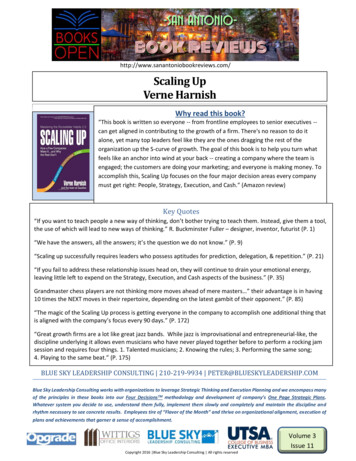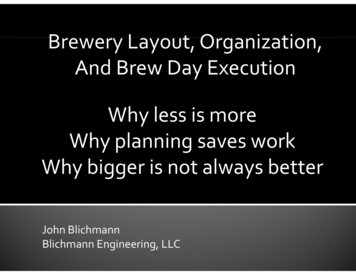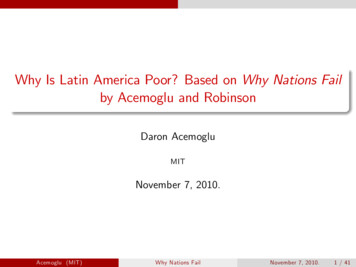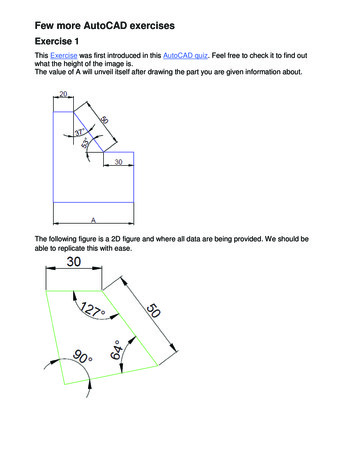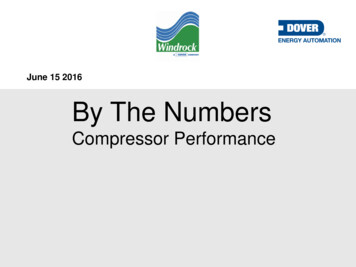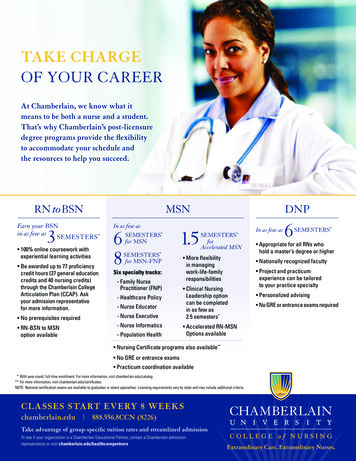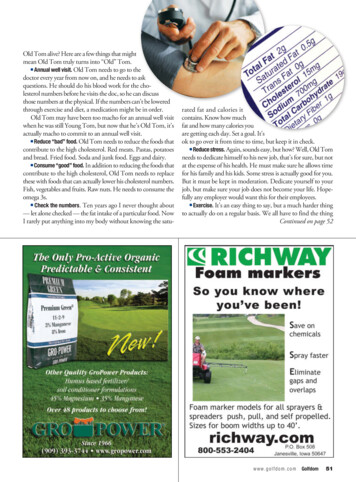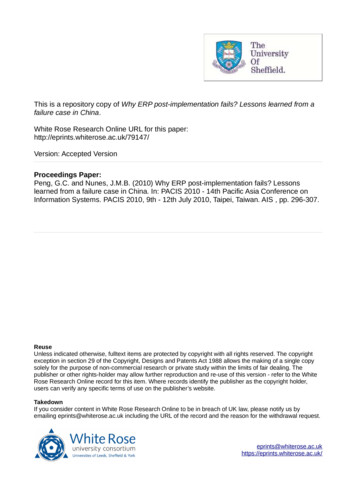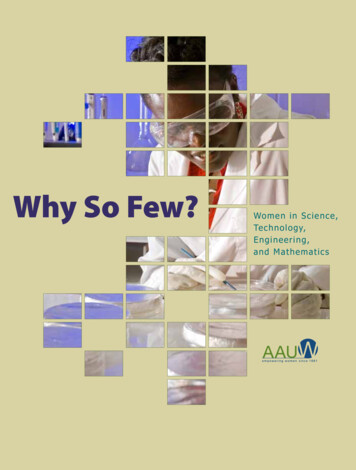
Transcription
Why So Few?Women in S c ienc e,Tec hnology,Engineering,and Mat hemat ic s
Why So Few?Women in Science, Technology, Engineering,and MathematicsCat h e r i n e H il l, Ph .D.Ch r i sti a n n e Cor b et tAnd resse St. R ose, Ed. D.
Published by AAUW1111 Sixteenth St. NWWashington, DC 20036Phone: 202/728-7602Fax: 202/463-7169E-mail: connect@aauw.orgWeb: www.aauw.orgCopyright 2010 AAUWAll rights reservedPrinted in the United StatesFirst printing: February 2010Library of Congress Control Number: 2010901076ISBN: 978-1-879922-40-2077-10 5M 02/10Cover: Esther Ngumbi, 2007–08 AAUW International Fellow; photo by the University of IdahoPhotography Department
This report was made possible by the generous contributions ofThe National Science Foundation,The Letitia Corum Memorial Fund,The Mooneen Lecce Giving Circle, andThe Eleanor Roosevelt FundThe Letitia Corum Memorial Fund honors the legacy ofLetitia Corumwhose commitment to AAUW continues to inspire advocacy and researchon the issues that matter in the lives of women and girls.The Mooneen Lecce Giving Circle provides support for programs that advance equity forwomen and girls.AAUW acknowledges the financial support of the National Science Foundation, Gender inScience and Engineering Division, grant 0832982, for the production and dissemination ofthis report. Any opinions, findings, and conclusions or recommendations expressed in thismaterial are those of the authors and do not necessarily reflect the views of the NationalScience Foundation.
Table of ContentsForewordixAcknowledgmentsxAbout the AuthorsxiiExecutive SummaryxiiiChapter 1. Women and Girls in Science, Technology,Engineering, and Mathematics1Chapter 2. Beliefs about Intelligence29Chapter 3. Stereotypes37Chapter 4. Self-Assessment43Chapter 5. Spatial Skills51Chapter 6. The College Student Experience57Chapter 7. University and College Faculty67Chapter 8. Implicit Bias73Chapter 9. Workplace Bias81Chapter 10. Recommendations89Bibliography97
Table of FiguresviFigure 1.High School Credits Earned in Mathematics andScience, by Gender, 1990–20054Figure 2.Grade Point Average in High School Mathematics andScience (Combined), by Gender, 1990–20054Figure 3.Students Taking Advanced Placement Tests inMathematics and Science, by Gender, 20096Figure 4.Average Scores on Advanced Placement Tests inMathematics and Science Subjects, by Gender, 20097Figure 5.Intent of First-Year College Students to Major inSTEM Fields, by Race-Ethnicity and Gender, 20068Figure 6.Bachelor’s Degrees Earned by Women in SelectedFields, 1966–20069Figure 7.Bachelor’s Degrees Earned in Selected Science andEngineering Fields, by Gender, 200710Figure 8.Bachelor’s Degrees Earned by UnderrepresentedRacial-Ethnic Groups in Selected STEM Fields, byGender, 200711Figure 9.Doctorates Earned by Women in Selected STEMFields, 1966–200612Figure 10.Women in Selected STEM Occupations, 200814Figure 11.Women in Selected STEM Occupations, 1960–200015Figure 12a. Workers with Doctorates in the Computer andInformation Sciences Workforce, by Gender andEmployment Status, 200616Figure 12b. Workers with Doctorates in the Biological, Agricultural,and Environmental Life Science Workforce, by Genderand Employment Status, 200616AAUW
Figure 13. Female STEM Faculty in Four-Year EducationalInstitutions, by Discipline and Tenure Status, 200618Figure 14. A Fixed versus a Growth Mindset32Figure 15. Performance on a Challenging Math Test, by StereotypeThreat Condition and Gender40Figure 16. Self-Assessment of Ability, by Gender48Figure 17. Students’ Standards for Their Own Performance, byGender49Figure 18. Sample Question from the Purdue Spatial VisualizationTest: Rotations (PSVT:R)54Figure 19. Process for Improving Recruitment and Retention ofWomen in Computer Science62Figure 20. Instructions for an Implicit Association Test on Genderand Science75Figure 21. Competence and Likability for Women and Men in“Male” Professions84Why So Few?vii
ForewordAAUW is proud to have been selected by the National Science Foundation to conduct thisstudy of women’s underrepresentation in science, technology, engineering, and mathematics.Since 1881, AAUW has encouraged women to study and work in these areas through fellowships and grants, research, programming, and advocacy. From local science camps and conferences to our groundbreaking research reports, AAUW has a long history of breaking throughbarriers for women and girls.Women have made tremendous progress in education and the workplace during the past 50years. Even in historically male fields such as business, law, and medicine, women have madeimpressive gains. In scientific areas, however, women’s educational gains have been less dramatic, and their progress in the workplace still slower. In an era when women are increasinglyprominent in medicine, law, and business, why are so few women becoming scientists andengineers?This study tackles this puzzling question and presents a picture of what we know—and what isstill to be understood—about girls and women in scientific fields. The report focuses on practical ways that families, schools, and communities can create an environment of encouragementthat can disrupt negative stereotypes about women’s capacity in these demanding fields. Bysupporting the development of girls’ confidence in their ability to learn math and science,we help motivate interest in these fields. Women’s educational progress should be celebrated,yet more work is needed to ensure that women and girls have full access to educational andemployment opportunities in science, technology, engineering, and mathematics.Linda D. HallmanAAUW Executive DirectorCarolyn H. GarfeinAAUW PresidentWhy So Few?ix
AcknowledgmentsAAUW is deeply grateful to the scholars whose work is profiled in the report: JoshuaAronson, Mahzarin Banaji, Shelley Correll, Carol Dweck, Allan Fisher, Madeline Heilman,Jane Margolis, Sheryl Sorby, Cathy Trower, and Barbara Whitten.AAUW thanks its staff and member leaders for their contributions. In particular AAUWis grateful for the exceptional work of Jill Birdwhistell, chief of strategic advancement;Rebecca Lanning, director of publications; Allison VanKanegan, designer; and Susan K. Dyer,consultant and editor.Finally, AAUW thanks the members of its distinguished research advisory committee for theirguidance. Special thanks go to Ruta Sevo for her work on the conceptual stage of the projectand her substantive comments on early drafts of the report.A d v i s o r y Co mm i ttee Bar bar a Bogue, co-founder and director of the Assessing Women and Men inEngineering (AWE) Project, associate professor of engineering science and mechanics,and director of the Women in Engineering Program, College of Engineering, Penn StateUniversity Meg A. Bond, professor of psychology and director of the Center for Women and Work,University of Massachusetts, Lowell, and resident scholar at the Brandeis UniversityWomen’s Studies Research Center Carol J. Burger, associate professor, Department of Interdisciplinary Studies, VirginiaTech, and founder and editor of the Journal of Women and Minorities in Science andEngineering Joanne McGr ath Coho on, assistant professor, Department of Science, Technology,and Society, University of Virginia, and senior research scientist at the National Center forWomen & IT (NCWIT) Margaret Eisenhar t, University Distinguished Professor and Charles Professor ofEducation, School of Education, University of Colorado, BoulderxAAUW
T. Ly nn Fountain, principal research scientist, Signature Technology Laboratory,Georgia Tech Research Institute; past president and vice president-program, AAUW ofGeorgia; and past president of the AAUW Atlanta (GA) Branch Bar bar a Gault, executive director and vice president, Institute for Women’sPolicy Research Yolanda S. George, deputy director of education and human resources programs,American Association for the Advancement of Science Gail Hac kett, provost and executive vice chancellor for academic affairs and professor ofcounseling and educational psychology, University of Missouri, Kansas City Diane F. Halp er n, professor of psychology, Claremont McKenna College, and pastpresident, American Psychological Association Alice Ho gan, retired program director, ADVANCE program, National ScienceFoundation, and independent consultant for programs and policies to advance theparticipation of women in academic science and engineering R uta S e vo, independent consultant and former senior program director for research ongender in science and engineering, National Science Foundation Marger y S ul livan, biologist, Laboratory of Malaria Vector Research, NationalInstitutes of Health; longtime member of AAUW; and AAUW ProgramCommittee member K aren L. Tonso, associate professor of educational foundations, Wayne State University,and former reservoir engineer in the petroleum industry V irginia Valian, co-director of the Hunter College Gender Equity Project andDistinguished Professor of Psychology and Linguistics at Hunter College and the CUNYGraduate CenterWhy So Few?xi
About the AuthorsC at h e r i n e H i l l , P h . D. , is the director of research at AAUW, where she focuseson higher education and women’s economic security. Prior to her work at AAUW, she wasa researcher at the Institute for Women’s Policy Research and an assistant professor at theUniversity of Virginia. She has bachelor’s and master’s degrees from Cornell University and adoctorate in public policy from Rutgers University.C h r i st i a n n e Co r b ett is a research associate at AAUW and co-author of Wherethe Girls Are: The Facts About Gender Equity in Education (2008). Before coming to AAUW,she worked as a legislative fellow in the office of Rep. Carolyn Maloney and as a mechanicaldesign engineer in the aerospace industry. She holds a master’s degree in cultural anthropologyfrom the University of Colorado, Boulder, and bachelor’s degrees in aerospace engineering andgovernment from the University of Notre Dame. As a Peace Corps volunteer in Ghana from1992 to 1994, she taught math and science to secondary school students.A n d r esse S t. R o se , E d. D. , is a research associate at AAUW, where she focuseson gender equity in education and the workplace. Before joining the AAUW staff, she workedas an academic counselor at Northeastern University in Boston and taught high school mathand biology at the International School of Port-of-Spain, Trinidad. She is a co-author ofWhere the Girls Are: The Facts About Gender Equity in Education (2008). She has a doctoraldegree in education policy from George Washington University, a master’s degree in highereducation administration from Boston College, and a bachelor’s degree in biology fromHamilton College.xiiAAUW
Executive Summary
The number of women in science and engineering is growing, yet men continue to outnumberwomen, especially at the upper levels of these professions. In elementary, middle, and highschool, girls and boys take math and science courses in roughly equal numbers, and about asmany girls as boys leave high school prepared to pursue science and engineering majors incollege. Yet fewer women than men pursue these majors. Among first-year college students,women are much less likely than men to say that they intend to major in science, technology,engineering, or math (STEM). By graduation, men outnumber women in nearly every scienceand engineering field, and in some, such as physics, engineering, and computer science, thedifference is dramatic, with women earning only 20 percent of bachelor’s degrees. Women’srepresentation in science and engineering declines further at the graduate level and yet againin the transition to the workplace.Drawing on a large and diverse body of research, this report presents eight recent researchfindings that provide evidence that social and environmental factors contribute to the underrepresentation of women in science and engineering. The rapid increase in the number of girlsachieving very high scores on mathematics tests once thought to measure innate ability suggests that cultural factors are at work. Thirty years ago there were 13 boys for every girl whoscored above 700 on the SAT math exam at age 13; today that ratio has shrunk to about 3:1.This increase in the number of girls identified as “mathematically gifted” suggests that education can and does make a difference at the highest levels of mathematical achievement. Whilebiological gender differences, yet to be well understood, may play a role, they clearly are notthe whole story.G i rl s’ Achievem ent s and I nterest in M ath an d S c ien ce AreShap e d by t he Environm ent a ro u n d Th emThis report demonstrates the effects of societal beliefs and the learning environment on girls’achievements and interest in science and math. One finding shows that when teachers andparents tell girls that their intelligence can expand with experience and learning, girls do better on math tests and are more likely to say they want to continue to study math in the future.That is, believing in the potential for intellectual growth, in and of itself, improves outcomes.This is true for all students, but it is particularly helpful for girls in mathematics, where negative stereotypes persist about their abilities. By creating a “growth mindset” environment,teachers and parents can encourage girls’ achievement and interest in math and science.Does the stereotype that boys are better than girls in math and science still affect girls today?Research profiled in this report shows that negative stereotypes about girls’ abilities in mathcan indeed measurably lower girls’ test performance. Researchers also believe that stereotypesxivAAUW
can lower girls’ aspirations for science and engineering careers over time. When test administrators tell students that girls and boys are equally capable in math, however, the difference inperformance essentially disappears, illustrating that changes in the learning environment canimprove girls’ achievement in math.The issue of self-assessment, or how we view our own abilities, is another area where culturalfactors have been found to limit girls’ interest in mathematics and mathematically challenging careers. Research profiled in the report finds that girls assess their mathematical abilitieslower than do boys with similar mathematical achievements. At the same time, girls holdthemselves to a higher standard than boys do in subjects like math, believing that they haveto be exceptional to succeed in “male” fields. One result of girls’ lower self-assessment of theirmath ability—even in the face of good grades and test scores—and their higher standards forperformance is that fewer girls than boys aspire to STEM careers. By emphasizing that girlsand boys achieve equally well in math and science, parents and teachers can encourage girls toassess their skills more accurately.One of the largest gender differences in cognitive abilities is found in the area of spatial skills,with boys and men consistently outperforming girls and women. Spatial skills are consideredby many people to be important for success in engineering and other scientific fields. Researchhighlighted in this report, however, documents that individuals’ spatial skills consistentlyimprove dramatically in a short time with a simple training course. If girls grow up in anenvironment that enhances their success in science and math with spatial skills training, theyare more likely to develop their skills as well as their confidence and consider a future in aSTEM field.At Co l l e g e s and U niver s it ies, Lit tle Ch an g es Can M ake a BigD i f fe re n ce i n At t rac t ing and R et a in in g Wo men in STEMThe foundation for a STEM career is laid early in life, but scientists and engineers are madein colleges and universities. Research profiled in this report demonstrates that small improvements by physics and computer science departments, such as providing a broader overview ofthe field in introductory courses, can add up to big gains in female student recruitment andretention. Likewise, colleges and universities can attract more female science and engineeringfaculty if they improve departmental culture to promote the integration of female faculty.Research described in this report provides evidence that women are less satisfied with theacademic workplace and more likely to leave it earlier in their careers than their malecounterparts are. College and university administrators can recruit and retain more women byimplementing mentoring programs and effective work-life policies for all faculty members.Why So Few?xv
B i a s, O f te n U ncons cious, Lim i ts Wo men’s Pro gress inS ci e nt i f i c and Engineer ing Fie ld sMost people associate science and math fields with “male” and humanities and arts fields with“female,” according to research examined in this report. Implicit bias is common, even amongindividuals who actively reject these stereotypes. This bias not only affects individuals’ attitudestoward others but may also influence girls’ and women’s likelihood of cultivating their owninterest in math and science. Taking the implicit bias test at https://implicit.harvard.educan help people identify and understand their biases so that they can work to compensatefor them.Not only are people more likely to associate math and science with men than with women,people often hold negative opinions of women in “masculine” positions, like scientists orengineers. Research profiled in this report shows that people judge women to be less competent than men in “male” jobs unless they are clearly successful in their work. When a womanis clearly competent in a “masculine” job, she is considered to be less likable. Because bothlikability and competence are needed for success in the workplace, women in STEM fieldscan find themselves in a double bind. If women and men in science and engineering knowthat this bias exists, they can work to interrupt the unconscious thought processes that leadto it. It may also help women specifically to know that if they encounter social disapprovalin their role as a computer scientist or physicist, it is likely not personal and there are ways tocounteract it.The striking disparity between the numbers of men and women in science, technology, engineering, and mathematics has often been considered as evidence of biologically driven genderdifferences in abilities and interests. The classical formulation of this idea is that men “naturally” excel in mathematically demanding disciplines, whereas women “naturally” excel in fieldsusing language skills. Recent gains in girls’ mathematical achievement, however, demonstratethe importance of culture and learning environments in the cultivation of abilities and interests. To diversify the STEM fields we must take a hard look at the stereotypes and biases thatstill pervade our culture. Encouraging more girls and women to enter these vital fields willrequire careful attention to the environment in our classrooms and workplaces and throughoutour culture.xviAAUW
Chapter 1.Women and Girls in Science,Technology, Engineering,and Mathematics
Science, technology, engineering, and mathematics (STEM) are widely regarded as critical to the national economy. Concern about America’s ability to be competitive in the globaleconomy has led to a number of calls to action to strengthen the pipeline into these fields(National Academy of Sciences, Committee on Science, Engineering & Public Policy, 2007;U.S. Government Accountability Office, 2006; U.S. Department of Education, 2006).Expanding and developing the STEM workforce is a critical issue for government, industryleaders, and educators. Despite the tremendous gains that girls and women have made ineducation and the workforce during the past 50 years, progress has been uneven, and certainscientific and engineering disciplines remain overwhelmingly male. This report addresseswhy there are still so few women in certain scientific and engineering fields and providesrecommendations to increase thenumber of women in these fields.Definition of Science, Technology,Engineering, and Mathematics (STEM)The National Science Foundationestimates that about five millionpeople work directly in science,STEM is defined in many ways (for example, see U.S. government definitions at http://nces.ed.gov/pubs2009/2009161engineering, and technology—.pdf ). In this report the term “STEM” refers to the physical,just over 4 percent of the workbiological, and agricultural sciences; computer and informa1force. This relatively small grouption sciences; engineering and engineering technologies;of workers is considered to beand mathematics. The social and behavioral sciences, such ascritical to economic innovationpsychology and economics, are not included, nor are healthand productivity. Workers inworkers, such as doctors and nurses. College and universitySTEM faculty are included when possible, but high schoolscience and engineering fieldsteachers in STEM subjects are not. While all of these workerstend to be well paid and enjoyare part of the larger scientific and engineering workforce,better job security than do othertheir exclusion is based on the availability of data. In thisworkers. Workforce projectionsreport the terms “STEM,” “science, technology, engineering,for 2018 by the U.S. Departmentand mathematics,” and “scientific and engineering fields” areof Labor show that nine of theused interchangeably.10 fastest-growing occupationsthat require at least a bachelor’sdegree will require significant scientific or mathematical training. Many science and engineering occupations are predicted to grow faster than the average rate for all occupations, andDefined by occupation, the United States science and engineering workforce totaled between 4.3 and 5.8 millionpeople in 2006. Those in science and engineering occupations who had bachelor’s degrees were estimated at between4.3 and 5.0 million. The National Science Foundation includes social scientists but not medical professionals inthese estimates (National Science Board, 2010). Estimates of the size of the scientific, engineering, and technological workforce are produced using different criteria by several U.S. government agencies including the Census Bureau,the National Science Foundation, and the Bureau of Labor Statistics. Defined more broadly, the size of the STEMworkforce has been estimated to exceed 21 million people.12AAUW
some of the largest increases will be in engineering- and computer-related fields—fields inwhich women currently hold one-quarter or fewer positions (Lacey & Wright, 2009; NationalScience Board, 2010).Attracting and retaining more women in the STEM workforce will maximize innovation,creativity, and competitiveness. Scientists and engineers are working to solve some of the mostvexing challenges of our time—finding cures for diseases like cancer and malaria, tacklingglobal warming, providing people with clean drinking water, developing renewable energysources, and understanding the origins of the universe. Engineers design many of the thingswe use daily—buildings, bridges, computers, cars, wheelchairs, and X-ray machines. Whenwomen are not involved in the design of these products, needs and desires unique to womenmay be overlooked. For example, “some early voice-recognition systems were calibrated to typical male voices. As a result, women’s voices were literally unheard. . Similar cases are found inmany other industries. For instance, a predominantly male group of engineers tailored the firstgeneration of automotive airbags to adult male bodies, resulting in avoidable deaths for womenand children” (Margolis & Fisher, 2002, pp. 2–3). With a more diverse workforce, scientificand technological products, services, and solutions are likely to be better designed and morelikely to represent all users.The opportunity to pursue a career in science, technology, engineering, and mathematics is alsoa matter of pay equity. Occupational segregation accounts for the majority of the wage gap(AAUW Educational Foundation, 2007), and although women still earn less than men earnin science and engineering fields, as they do on average in the overall workforce, women inscience and engineering tend to earn more than women earn in other sectors of the workforce.According to a July 2009 survey, the average starting salary for someone with a bachelor’sdegree in mechanical engineering, for example, was just over 59,000. By comparison, theaverage starting salary for an individual with a bachelor’s degree in economics was just under 50,000 (National Association of Colleges and Employers, 2009).P r epa r at i o n o f G i r l s f o r S T E M F i e l d sMath skills are considered essential to success in STEM fields. Historically, boys have outperformed girls in math, but in the past few decades the gender gap has narrowed, and today girlsare doing as well as boys in math on average (Hyde et al., 2008). Girls are earning high schoolmath and science credits at the same rate as boys and are earning slightly higher grades inthese classes (U.S. Department of Education, National Center for Education Statistics, 2007)(see figures 1 and 2).Why So Few?3
Figure 1. High School Credits Earned in Mathematicsand Science, by Gender, 1990–20058.0 Girls BoysCourse .519901994199820002005High School Graduation YearSource: U.S. Department of Education, National Center for Education Statistics, 2007, The Nation's Report Card: America's high school graduates:Results from the 2005 NAEP High School Transcript Study, by C. Shettle et al. (NCES 2007-467) (Washington, DC: Government Printing Office).Figure 2. Grade Point Average in High School Mathematicsand Science (Combined), by Gender, 1990–20053.00 Girls Boys2.762.72Grade Point 02.3019901994199820002005High School Graduation YearSource: U.S. Department of Education, National Center for Education Statistics, 2007, The Nation's Report Card: America's high school graduates:Results from the 2005 NAEP High School Transcript Study, by C. Shettle et al. (NCES 2007-467) (Washington, DC: Government Printing Office).4AAUW
On high-stakes math tests, however, boys continue to outscore girls, albeit by a small margin.A small gender gap persists on the mathematics section of the SAT and the ACT examinations (Halpern, Benbow, et al., 2007; AAUW, 2008). Fewer girls than boys take advancedplacement (AP) exams in STEM-related subjects such as calculus, physics, computer science,and chemistry (see figure 3), and girls who take STEM AP exams earn lower scores than boysearn on average (see figure 4). Research on “stereotype threat,” profiled in chapter 3, shedslight on the power of stereotypes to undermine girls’ math test performance and may helpexplain the puzzle of girls’ strong classroom performance and relatively weaker performanceon high-stakes tests such as these.One notable gain is girls’ increased representation in the ranks of the highest achievers inmathematics. Among students with very high scores on math tests, boys continue to outnumber girls (Lubinski & Benbow, 1992, 2006; Hedges & Nowell, 1995); however, the proportionof girls among the highest math achievers has greatly increased during the past few decades.The Study of Mathematically Precocious Youth identifies seventh and eighth graders whoscore greater than 700 on the SAT math section (the top 0.01 percent or 1 in 10,000 students). Since the early 1980s the ratio of boys to girls in this extremely select group has dramatically declined from 13:1 (Benbow & Stanley, 1983) to around 3:1 in recent years (Brody& Mills, 2005; Halpern, Benbow, et al., 2007).Students from historically disadvantaged groups such as African American and Hispanicstudents, both female and male, are less likely to have access to advanced courses in math andscience in high school, which negatively affects their ability to enter and successfully completeSTEM majors in college (May & Chubin, 2003; Frizell & Nave, 2008; Tyson et al., 2007;Perna et al., 2009). In 2005, 31 percent of Asian American and 16 percent of white highschool graduates completed calculus, compared with 6 percent and 7 percent of AfricanAmerican and Hispanic high school graduates, respectively. Additionally, one-quarter of AsianAmerican and one-tenth of white high school graduates took either the AP or InternationalBaccalaureate exam in calculus, compared with just 3.2 percent of African American and5.6 percent of Hispanic graduates (National Science Board, 2008). Yet even among underrepresented racial-ethnic groups, a growing number of girls are leaving high school well prepared in math and science and capable of pursuing STEM majors in college.W o me n i n S T E M i n Co l l eges a n d U n i v e r s i t i esThe transition between high school and college is a critical moment when many young womenturn away from a STEM career path. Although women are the majority of college students,they are far less likely than their male peers to plan to major in a STEM field (see figure 5).Why So Few?5
Figure 3. Students Taking Advanced Placement Testsin Mathematics and Science, by Gender, 11440,809Number of ce: Retrieved November 11, 2009, from the College Board website at www.collegeboard.com.6AAUW Computer science AB Physics C - Electricityand magnetism Computer science A Physics C - Mechanics Physics B Calculus BC Environmental science Chemistry Biology Calculus AB
Figure 4. Average Scores on Advanced Placement Tests inMathematics and Science Subjects, by Gender, 2009 Girls Boys5.04.5AP Test Scores (Scale 1–5)4.03.8
American Association for the Advancement of Science . Thirty years ago there were 13 boys for every girl who scored above 700 on the SAT math exam at age 13; today that ratio has shrunk to about

